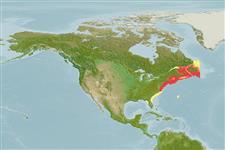分類 / Names
共通名の | 類義語 | Catalog of Fishes(部類, 種) | ITIS | CoL | WoRMS | Cloffa
>
Clupeiformes (Herrings) >
Alosidae (Shads and Sardines)
Etymology: Alosa: Latin, alausa = a fish cited by Ausonius and Latin, halec = pickle, dealing with the Greek word hals = salt; it is also the old Saxon name for shad = "alli" ; 1591 (Ref. 45335); sapidissima: sapidissima meaning most delicious (Ref. 1998).
Environment: milieu / climate zone / depth range / distribution range
生態学
海; 新鮮な水; 汽水性の; 昇流魚 (Ref. 51243); 深さの範囲 0 - 250 m (Ref. 6793). Subtropical; 54°N - 28°N, 84°W - 52°W (Ref. 86798)
North America: Atlantic coast from Labrador, Canada to St. Johns River, Florida, USA; ascends coastal rivers during spring spawning migrations. Introduced into Sacramento River, California in 1870s and has spread along Pacific Coast from Kamchatka, Russia to Todos Santos Bay, Mexico. Landlocked in Millerton Lake, California, USA.
Length at first maturity / サイズ / 重さ / 年齢
Maturity: Lm 43.4, range 38 - 48.5 cm
Max length : 76.0 cm TL オス/雌雄の選別がない; (Ref. 6885); 61.7 cm SL (female); common length : 50.0 cm SL オス/雌雄の選別がない; (Ref. 188); 最大公表体重: 5.5 kg (Ref. 7251); 最大記録サイズ: 13 年 (Ref. 72462)
背面の脊椎 (合計): 0; 背鰭 (合計): 15-19; 肛門の骨 0; 臀鰭: 18 - 24; 脊つい: 51 - 60. Moderately compressed, belly with a distinct keel. Lower jaw not rising steeply within mouth. Gill rakers long and slender (fewer in young). Silvery in color with blue or blue-green metallic luster on back (Ref. 1998). A dark spot on shoulder, sometimes followed by several more, or even a second row. Resembles A. pseudoharengus with lower jaw rising steeply within mouth, eyes larger, and fewer lower gill rakers, as also A. aestivalis and A. mediocris (Ref. 188). Silvery, with a green or bluish back (Ref. 7251). Branchiostegal rays 7 (Ref. 4639).
Spends most of its life at sea, returning to freshwater streams to breed (Ref. 27547). Inhabits open water of large rivers (Ref. 86798). Non-spawning adults are found in schools near the surface of continental shelf waters in spring, summer and fall (Ref. 7135); also found in brackish waters (Ref. 4607). Newly hatched larvae are found in rivers during the summer; by autumn they enter the sea and remain there until maturity. Juveniles form schools at 20-30 mm TL and gradually move downstream (Ref. 4639). Feeds on plankton, mainly copepods and mysids, occasionally on small fishes. Feeding ceases during upstream spawning migration and resumes during the downstream post-spawning migration (Ref. 1998). Commercially caught in rivers and estuaries during spawning migration (Ref. 1998). Utilized fresh, salted, or smoked. The roe is esteemed. Eaten pan-fried, broiled, and baked (Ref. 9988). Possibly to 375 m depth (Ref. 6793). Parasites found are nematodes, Acanthocephala, copepods and distomes (Ref. 37032).
Life cycle and mating behavior
成熟 | 繁殖 | 放精 | 卵 | 生産力 | 幼生
Some shad spawn immediately on entering fresh water while others may undertake fairly long journeys, as much as 630 km upstream, to their favored spawning grounds (Ref. 4607). Enters rivers as early as November (Florida) and as late as May or June in the north, depending on water temperature (peak runs at about 18.5 °C). Spawning occurs at sundown and continues until after midnight. The fish pair and swim close together, releasing eggs and milt (Ref. 27547). Adults descend shortly after spawning, the young in the autumn.
Spawning reported from 8-26°C, generally occurs at 12-21°C (Ref. 38954).
Whitehead, P.J.P., 1985. FAO Species Catalogue. Vol. 7. Clupeoid fishes of the world (suborder Clupeoidei). An annotated and illustrated catalogue of the herrings, sardines, pilchards, sprats, shads, anchovies and wolf-herrings. FAO Fish. Synop. 125(7/1):1-303. Rome: FAO. (Ref. 188)
Human uses
水産業: 商業; ゲームフィッシュ: はい
より多くの情報
協力者画像Stamps, Coins Misc.音シガテラ(食中毒の名前)速度泳ぐ 型式カマOtoliths脳視覚
用具
特記事項
XMLをダウンロードして下さい
インターネットの情報源
Estimates based on models
Preferred temperature (Ref.
123201): 0.5 - 11.5, mean 5.6 °C (based on 113 cells).
Phylogenetic diversity index (Ref.
82804): PD
50 = 0.5000 [Uniqueness, from 0.5 = low to 2.0 = high].
Bayesian length-weight: a=0.00646 (0.00356 - 0.01171), b=3.00 (2.85 - 3.15), in cm total length, based on LWR estimates for this species & Genus-body shape (Ref.
93245).
栄養段階 (Ref.
69278): 3.5 ±0.3 se; based on diet studies.
Generation time: 5.5 ( na - na) years. Estimated as median ln(3)/K based on 1
growth studies.
回復力 (Ref.
120179): 低い, 4.5年~14年の倍増期間の最小個体群 (K=0.14; tm=4.7).
Fishing Vulnerability (Ref.
59153): Moderate to high vulnerability (50 of 100).
Climate Vulnerability (Ref.
125649): Moderate vulnerability (44 of 100).
Nutrients (Ref.
124155): Calcium = 19.3 [10.1, 94.6] mg/100g; Iron = 1.41 [0.61, 3.68] mg/100g; Protein = 19.9 [17.4, 22.6] %; Omega3 = 0.77 [0.41, 1.51] g/100g; Selenium = 30.3 [16.6, 55.9] μg/100g; VitaminA = 10.2 [2.6, 43.4] μg/100g; Zinc = 0.412 [0.273, 0.736] mg/100g (wet weight); based on
nutrient studies.
